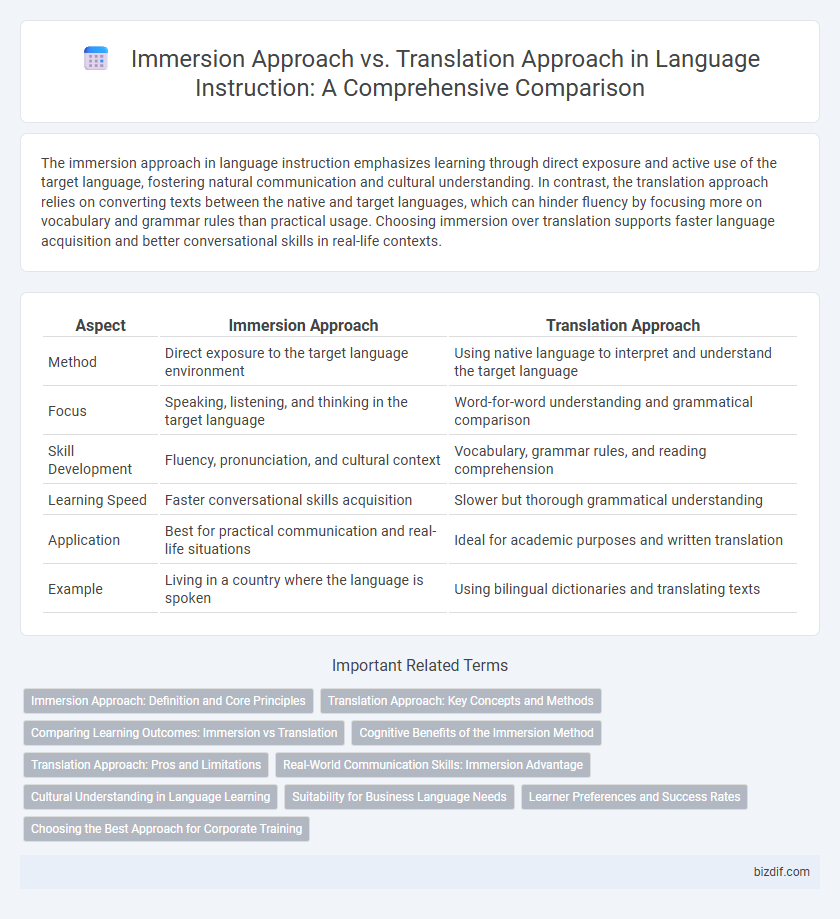The immersion approach in language instruction emphasizes learning through direct exposure and active use of the target language, fostering natural communication and cultural understanding. In contrast, the translation approach relies on converting texts between the native and target languages, which can hinder fluency by focusing more on vocabulary and grammar rules than practical usage. Choosing immersion over translation supports faster language acquisition and better conversational skills in real-life contexts.
Table of Comparison
| Aspect | Immersion Approach | Translation Approach |
|---|---|---|
| Method | Direct exposure to the target language environment | Using native language to interpret and understand the target language |
| Focus | Speaking, listening, and thinking in the target language | Word-for-word understanding and grammatical comparison |
| Skill Development | Fluency, pronunciation, and cultural context | Vocabulary, grammar rules, and reading comprehension |
| Learning Speed | Faster conversational skills acquisition | Slower but thorough grammatical understanding |
| Application | Best for practical communication and real-life situations | Ideal for academic purposes and written translation |
| Example | Living in a country where the language is spoken | Using bilingual dictionaries and translating texts |
Immersion Approach: Definition and Core Principles
The immersion approach in language instruction emphasizes learning through direct exposure to the target language in natural contexts, prioritizing comprehension and communication over explicit grammar instruction. Core principles include fostering an environment where learners interact exclusively in the target language, encouraging active listening and speaking skills to develop fluency. This approach leverages contextual cues and meaningful communication, facilitating cognitive connections that enhance long-term language retention and cultural understanding.
Translation Approach: Key Concepts and Methods
The Translation Approach in language instruction emphasizes the direct conversion between the target language and the native language, leveraging bilingual vocabulary and grammar as core tools. This method involves sentence-by-sentence translation exercises, enabling learners to understand syntax and semantics through comparative analysis. Key concepts include explicit grammar instruction, vocabulary memorization, and written translation practice to build linguistic competence and accuracy.
Comparing Learning Outcomes: Immersion vs Translation
Immersion approach enhances language fluency by exposing learners to natural-speaking environments, facilitating intuitive understanding and real-time communication skills. Translation approach improves vocabulary and grammatical accuracy through direct comparisons between native and target languages but may limit conversational proficiency. Studies indicate immersion learners achieve higher speaking and listening comprehension levels, while translation-focused students excel in reading and writing accuracy.
Cognitive Benefits of the Immersion Method
The immersion approach enhances cognitive flexibility by encouraging learners to think directly in the target language, which improves problem-solving and multitasking skills. Studies show this method strengthens memory retention through contextual learning, engaging multiple brain areas simultaneously. Unlike the translation approach, immersion reduces reliance on native language processing, fostering faster and more natural fluency development.
Translation Approach: Pros and Limitations
The translation approach in language instruction facilitates understanding by directly connecting new vocabulary and grammar to the learner's native language, enhancing comprehension and retention. It allows learners to analyze language structures systematically, which can aid in developing strong reading and writing skills. However, this method often limits conversational fluency and spontaneous language use, as it relies heavily on native language interference rather than immersive practice.
Real-World Communication Skills: Immersion Advantage
The immersion approach significantly enhances real-world communication skills by fostering natural language acquisition through contextual and interactive experiences. Unlike the translation approach, which emphasizes direct language equivalence and often limits conversational proficiency, immersion allows learners to internalize vocabulary, syntax, and cultural nuances organically. Research from applied linguistics confirms that immersion environments lead to higher fluency and better adaptability in spontaneous communication scenarios.
Cultural Understanding in Language Learning
Immersion approach fosters deep cultural understanding by surrounding learners with authentic language use and cultural contexts, enhancing intuitive comprehension of social norms and customs. The translation approach emphasizes linguistic accuracy but often overlooks cultural nuances, limiting learners' ability to engage fully with the target culture. Immersion cultivates practical communication skills and cultural empathy essential for real-world language proficiency.
Suitability for Business Language Needs
The Immersion approach excels in developing practical communication skills and cultural fluency essential for real-world business interactions, making it highly suitable for professionals needing conversational competence in dynamic environments. The Translation approach emphasizes accuracy and vocabulary depth, beneficial for roles requiring precise document comprehension and multilingual content management. Selecting between these methods depends on whether the business prioritizes interactive dialogue skills or detailed language accuracy for written materials.
Learner Preferences and Success Rates
Learner preferences often favor the immersion approach due to its emphasis on natural language acquisition and cultural context, which enhances fluency and comprehension. Studies reveal higher success rates in communication skills and long-term retention with immersion compared to the translation approach, which may benefit learners needing quick vocabulary recognition and grammatical understanding. Immersion supports active language use and contextual learning, leading to greater learner engagement and sustained proficiency.
Choosing the Best Approach for Corporate Training
The immersion approach in corporate training emphasizes practical language use and real-life scenarios, enhancing employee fluency and cultural understanding, which leads to better communication in global business settings. In contrast, the translation approach focuses on literal language skills and accuracy, benefiting roles requiring precise interpretation of documents and technical materials. Choosing the best approach depends on corporate goals: immersion suits dynamic environments needing conversational proficiency, while translation supports detailed accuracy for specialized tasks.
Immersion approach vs Translation approach Infographic

 bizdif.com
bizdif.com